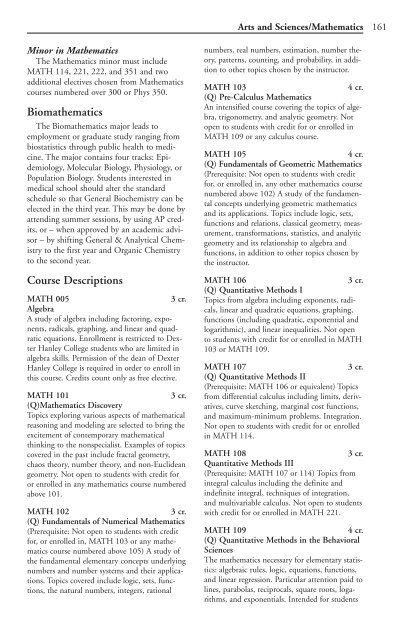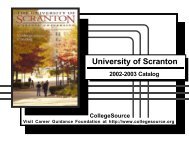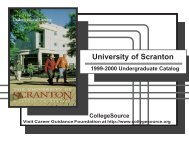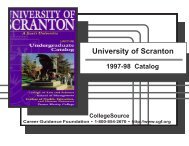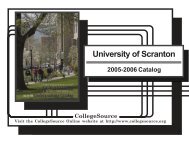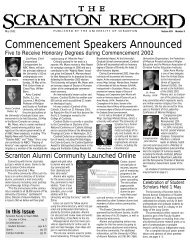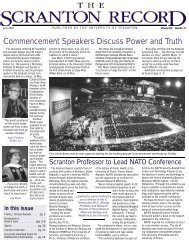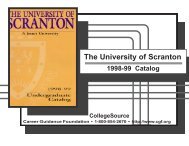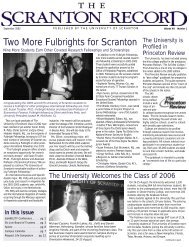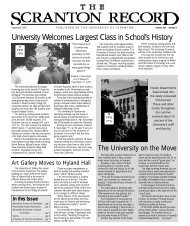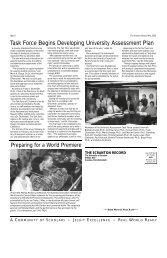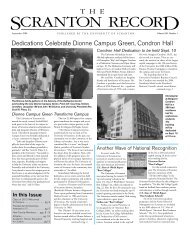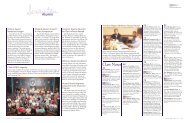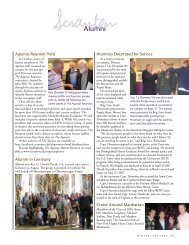2003-2004 - The University of Scranton
2003-2004 - The University of Scranton
2003-2004 - The University of Scranton
Create successful ePaper yourself
Turn your PDF publications into a flip-book with our unique Google optimized e-Paper software.
Minor in Mathematics<br />
<strong>The</strong> Mathematics minor must include<br />
MATH 114, 221, 222, and 351 and two<br />
additional electives chosen from Mathematics<br />
courses numbered over 300 or Phys 350.<br />
Biomathematics<br />
<strong>The</strong> Biomathematics major leads to<br />
employment or graduate study ranging from<br />
biostatistics through public health to medicine.<br />
<strong>The</strong> major contains four tracks: Epidemiology,<br />
Molecular Biology, Physiology, or<br />
Population Biology. Students interested in<br />
medical school should alter the standard<br />
schedule so that General Biochemistry can be<br />
elected in the third year. This may be done by<br />
attending summer sessions, by using AP credits,<br />
or – when approved by an academic advisor<br />
– by shifting General & Analytical Chemistry<br />
to the first year and Organic Chemistry<br />
to the second year.<br />
Course Descriptions<br />
MATH 005 3 cr.<br />
Algebra<br />
A study <strong>of</strong> algebra including factoring, exponents,<br />
radicals, graphing, and linear and quadratic<br />
equations. Enrollment is restricted to Dexter<br />
Hanley College students who are limited in<br />
algebra skills. Permission <strong>of</strong> the dean <strong>of</strong> Dexter<br />
Hanley College is required in order to enroll in<br />
this course. Credits count only as free elective.<br />
MATH 101 3 cr.<br />
(Q)Mathematics Discovery<br />
Topics exploring various aspects <strong>of</strong> mathematical<br />
reasoning and modeling are selected to bring the<br />
excitement <strong>of</strong> contemporary mathematical<br />
thinking to the nonspecialist. Examples <strong>of</strong> topics<br />
covered in the past include fractal geometry,<br />
chaos theory, number theory, and non-Euclidean<br />
geometry. Not open to students with credit for<br />
or enrolled in any mathematics course numbered<br />
above 101.<br />
MATH 102 3 cr.<br />
(Q) Fundamentals <strong>of</strong> Numerical Mathematics<br />
(Prerequisite: Not open to students with credit<br />
for, or enrolled in, MATH 103 or any mathematics<br />
course numbered above 105) A study <strong>of</strong><br />
the fundamental elementary concepts underlying<br />
numbers and number systems and their applications.<br />
Topics covered include logic, sets, functions,<br />
the natural numbers, integers, rational<br />
Arts and Sciences/Mathematics 161<br />
numbers, real numbers, estimation, number theory,<br />
patterns, counting, and probability, in addition<br />
to other topics chosen by the instructor.<br />
MATH 103 4 cr.<br />
(Q) Pre-Calculus Mathematics<br />
An intensified course covering the topics <strong>of</strong> algebra,<br />
trigonometry, and analytic geometry. Not<br />
open to students with credit for or enrolled in<br />
MATH 109 or any calculus course.<br />
MATH 105 4 cr.<br />
(Q) Fundamentals <strong>of</strong> Geometric Mathematics<br />
(Prerequisite: Not open to students with credit<br />
for, or enrolled in, any other mathematics course<br />
numbered above 102) A study <strong>of</strong> the fundamental<br />
concepts underlying geometric mathematics<br />
and its applications. Topics include logic, sets,<br />
functions and relations, classical geometry, measurement,<br />
transformations, statistics, and analytic<br />
geometry and its relationship to algebra and<br />
functions, in addition to other topics chosen by<br />
the instructor.<br />
MATH 106 3 cr.<br />
(Q) Quantitative Methods I<br />
Topics from algebra including exponents, radicals,<br />
linear and quadratic equations, graphing,<br />
functions (including quadratic, exponential and<br />
logarithmic), and linear inequalities. Not open<br />
to students with credit for or enrolled in MATH<br />
103 or MATH 109.<br />
MATH 107 3 cr.<br />
(Q) Quantitative Methods II<br />
(Prerequisite: MATH 106 or equivalent) Topics<br />
from differential calculus including limits, derivatives,<br />
curve sketching, marginal cost functions,<br />
and maximum-minimum problems. Integration.<br />
Not open to students with credit for or enrolled<br />
in MATH 114.<br />
MATH 108 3 cr.<br />
Quantitative Methods III<br />
(Prerequisite: MATH 107 or 114) Topics from<br />
integral calculus including the definite and<br />
indefinite integral, techniques <strong>of</strong> integration,<br />
and multivariable calculus. Not open to students<br />
with credit for or enrolled in MATH 221.<br />
MATH 109 4 cr.<br />
(Q) Quantitative Methods in the Behavioral<br />
Sciences<br />
<strong>The</strong> mathematics necessary for elementary statistics:<br />
algebraic rules, logic, equations, functions,<br />
and linear regression. Particular attention paid to<br />
lines, parabolas, reciprocals, square roots, logarithms,<br />
and exponentials. Intended for students


